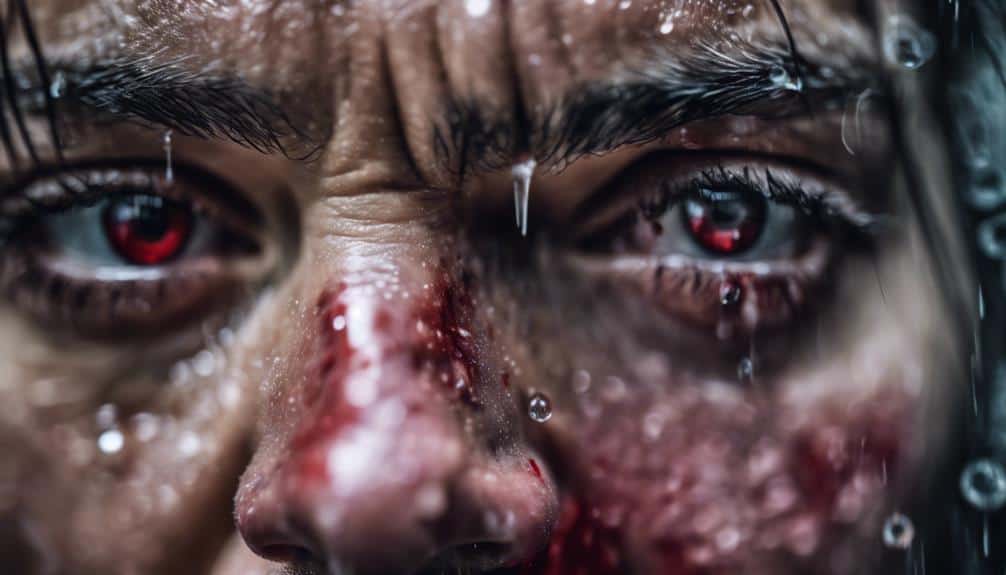When you get hit with
pepper spray, it feels like your face just got shoved into a volcano, and breathing turns into a cruel joke. Your eyes slam shut, burning like they’re on fire, while your skin feels like a swarm of angry bees launched an attack.
Panic sets in fast, making you gasp for air that seems impossible to find. It’s not just about pain; it’s
pure agony, mixed with a side of sheer terror. You can’t see, can’t breathe, and every second drags on forever. Want to know how to actually handle this nightmare and
stay safe next time?
The Pepper Spray Paradox
The
pepper spray paradox, at its core, underscores the conflicting views surrounding its use as a
self-defense tool. You’ve probably heard people debate whether it’s a reliable way to protect yourself or just a recipe for disaster. When you hit that initial spray, you’re aiming for
immediate results, right? The main ingredient in pepper spray,
oleoresin capsicum, is supposed to cause
intense burning, a runny nose, and temporary blindness. However, many users find that a
stylish option like the
Pink Mace Keyguard® Pepper Spray offers both effectiveness and aesthetic appeal. But here’s the kicker: it doesn’t always go as planned.
Picture this: you’re in a tough spot, you whip out your pepper spray, and let it fly.
Windy day? Your face could become the victim instead. And let’s not forget the
quality of the spray—some are exceptional, others, not so much. So, it’s all a bit of a gamble.
Plus, its effects are temporary. You might get a few minutes to run, but what if your attacker shakes it off sooner than expected? You’ve got to have a backup plan. It’s not just a magic wand; it’s a tool that requires strategy and realistic expectations. Balancing these risks and benefits is key to making it work for you.
Secondary Exposure Risks
Given the uncertainties surrounding the effectiveness of
pepper spray, it’s important to contemplate
secondary exposure risks. Imagine this: you’re carrying pepper spray for self-defense, but a little bit of wind can turn your safety net into a shared nightmare. When you spray, the wind or movement can carry those
irritating particles to bystanders or even back at you. While it’s not as intense as a direct hit,
inhaling small amounts of the spray can still make you cough and irritate your throat. The
1.4% Major Capsaicinoids content in products like WildFire makes it a powerful deterrent, but also highlights the need for
careful use to avoid unintended consequences.
Picture yourself in an open park, needing to use the spray. Keeping a safe distance from the spray’s path and using it in open spaces can really help minimize those risks. But let’s be real, preparing mentally for the potential effects, like
temporary eye irritation or respiratory discomfort, is just as important. You don’t want to be caught off guard, right?
Testing and Effectiveness
Testing and ensuring the effectiveness of your pepper spray is essential for reliable self-defense. You don’t want to find out in a crisis that your nozzle functionality is faulty or that your spray deployment is weak. Imagine the horror of pressing that button and nothing happens. That’s why it’s vital to periodically test your pepper spray in a safe, controlled environment.
When it comes to choosing the right formulation, it’s a good idea to compare the different types available. Fast-acting stream-style sprays are generally more effective, providing immediate incapacitation. Gel or foam formulations might seem appealing, but they don’t act as quickly and can be less reliable in a pinch.
Here’s a quick comparison to help you decide:
| Formulation Type |
Effectiveness |
Deployment Speed |
| Stream-Style |
High |
Immediate |
| Gel |
Medium |
Moderate |
| Foam |
Low |
Slow |
Make sure you’re comfortable with how your pepper spray works. Practice handling it, so if the time comes, you won’t hesitate. Remember, those precious seconds can make all the difference. Keep a safe distance to avoid secondary exposure and stay prepared. Your safety depends on it!
Victim Reactions
When you get hit with
pepper spray, your eyes will
sting like they’re on fire, and you’ll probably be tearing up and unable to see, which can make you feel helpless and panicked. You’ll also cough and feel a burning sensation in your throat and lungs, making it
hard to breathe and adding to the chaos. Even if you’re just nearby, you might get a whiff of it, leaving you and others around coughing and choking, though not as badly as the person directly sprayed.
Immediate Physical Reactions
Exposure to pepper spray results in immediate and intense physical reactions that can incapacitate a victim temporarily. Imagine your eyes suddenly feeling like they’re on fire. The eye irritation symptoms are brutal tearing, burning, and involuntary eye closure make it impossible to see. You’re stumbling, trying to open your eyes, but they just won’t cooperate.
And then there’s the respiratory distress. Your throat feels like it’s closing up, coughing becomes uncontrollable, and the mucus buildup in your nose and mouth makes you feel like you’re drowning in your own body. Breathing becomes a Herculean task, each inhalation a struggle against the suffocating sensation.
Skin inflammation adds another layer of torment. Your face and any exposed skin turn red and inflamed, feeling like you’ve been rubbed with a thousand chili peppers. While blistering is rare, the irritation is enough to make you want to jump into the nearest ice bath.
| Symptom |
Description |
| Eye Irritation |
Burning, tearing, involuntary closure |
| Respiratory Distress |
Throat irritation, coughing, suffocation feeling |
| Skin Inflammation |
Redness, inflammation, rare blistering |
| Duration |
Typically 15-30 minutes until normal function resumes |
The whole experience is like being tossed into a tornado of agony, leaving you desperate for relief.
Psychological Response Patterns
Victims of pepper spray often experience an immediate and
overwhelming panic response. The
intense burning sensation and
inability to open your eyes can make you feel utterly helpless and anxious. Imagine the worst sunburn you’ve ever had—now put that in your eyes and face. It’s like your body goes into full-on freak-out mode, and you can’t even see what’s happening around you. Products like the
Mace Pepper Spray Jogger are designed for easy carrying during outdoor activities, but in a moment of crisis, they can seem like a double-edged sword.
The
physiological effects, like gagging and mucus buildup, just add fuel to the fire. You might feel like you’re suffocating, which only ramps up your distress. Your eyes slam shut instinctively, and that
loss of control can trigger a full-blown
panic attack. It’s like being trapped in your own body, unable to escape the torment.
But here’s where
emotional resilience comes into play. Repeated exposure, as seen in Marine training, helps you develop
coping strategies. You learn to manage your fear better, discovering ways to keep calm under pressure. Understanding these psychological responses can equip you with better
fear management techniques in real-life self-defense situations. So while the initial exposure is sheer agony, knowing what to expect can help you handle the chaos just a bit better next time.
Limitations and Realities
Pepper spray is often seen as a reliable
self-defense tool, but it’s important to understand its limitations and realities. While it can temporarily
incapacitate an attacker, the effects usually last just 15 to 45 minutes, so you need to plan
follow-up actions for personal safety. It’s also worth noting that the
Pepper Shot spray contains 1.2%
Major Capsaicinoids, which can cause significant discomfort for an assailant its active ingredient. Wind and distance can mess with its
effectiveness, so keep realistic expectations in mind and consider other self-defense strategies.
Imagine spraying it in the wind—yikes, the spray could blow back at you! Secondary exposure might not be as bad as direct, but still, it stings and can make you cough like crazy. So, always maintain distance when you use it. And let’s talk about the
psychological impact—both on you and the attacker. When you’re in a panic, feeling helpless, it’s tough to think straight, but staying calm is essential. The attacker might not be completely out of commission either; they could still pose a threat even with eyes shut and struggling to breathe.
Pepper spray is a part of your
emergency preparedness, but it’s not foolproof. Be ready with a
backup plan, stay aware, and don’t rely on just one method to keep yourself safe.
Safety and Awareness
When it comes to using pepper spray,
safety and awareness are paramount. First off,
prevention techniques are key. Always use pepper spray outdoors; indoor use can turn your living room into a gas chamber. Trust me, you don’t want that. Keep it out of kids’ reach, unless you fancy a trip to the ER.
Protective eyewear? Not just for nerds. It saves your eyes during testing or handling. Additionally, remember that the 3-in-1 formula of the
Mace Triple Action Personal Pepper Spray includes tear gas, which can greatly increase the
disorientation of an attacker.
Now, let’s talk
mishaps. If you get it on your skin,
wash with soap and water right away. For
respiratory issues, head to fresh air and hydrate. It’s like getting over a bad cold, but in turbo mode.
Public education is your friend here. Read those labels. Seriously, they aren’t just for decoration.
Community involvement can also make a huge difference. Workshops can teach you and your neighbors the effects and proper use of pepper spray. Imagine a community where everyone knows how to handle this stuff—safety heaven, right?
Educational resources are everywhere. Take advantage of them, and you’ll be a pepper spray pro in no time. So, stay safe, stay informed, and remember
knowledge is your best defense.
Frequently Asked Questions
How Bad Is Getting OC Sprayed?
Getting OC sprayed feels like walking through fire. The effects include intense eye irritation, respiratory distress, and skin burning. The recovery process is usually quick, but immediately follow safety precautions like seeking fresh air and flushing your eyes.
How Painful Is Pepper Spray in the Eyes?
Pepper spray causes immediate reactions like intense burning and tearing, leading to temporary blindness. Long-term effects can include corneal damage. The psychological impact is significant, as the pain and fear can be traumatic and lingering.
Pepper spray remedies include rinsing your eyes with water or saline, which provides instant relief. Eye wash solutions for chemical exposure are also effective. Avoid rubbing your eyes to prevent further irritation and seek medical help if needed.
What Is the Failure Rate of OC Spray?
OC spray’s failure rate is about 10-15%, making it effective approximately 85-90% of the time. When comparing effectiveness, consider self-defense alternatives and legal implications to guarantee your chosen method suits your needs and circumstances.







